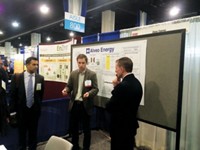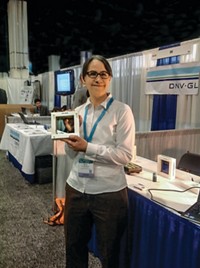Advertisement
Grab your lab coat. Let's get started
Welcome!
Welcome!
Create an account below to get 6 C&EN articles per month, receive newsletters and more - all free.
It seems this is your first time logging in online. Please enter the following information to continue.
As an ACS member you automatically get access to this site. All we need is few more details to create your reading experience.
Not you? Sign in with a different account.
Not you? Sign in with a different account.
ERROR 1
ERROR 1
ERROR 2
ERROR 2
ERROR 2
ERROR 2
ERROR 2
Password and Confirm password must match.
If you have an ACS member number, please enter it here so we can link this account to your membership. (optional)
ERROR 2
ACS values your privacy. By submitting your information, you are gaining access to C&EN and subscribing to our weekly newsletter. We use the information you provide to make your reading experience better, and we will never sell your data to third party members.
Business
ARPA-E Summit Highlights Early Successes In Energy Innovation
Support for transformative technologies continues in face of government budget cutting
by Melody M. Bomgardner
March 18, 2013
| A version of this story appeared in
Volume 91, Issue 11
The impending budget cuts known as sequestration cast a shadow over Washington, D.C., in late February as the Department of Energy kicked off its Energy Innovation Summit, a gathering of researchers, government officials, and businesspeople affiliated with the Advanced Research Projects Agency-Energy, or ARPA-E. But the tone of the conference, held just outside the city, was comparatively sunny.
The ARPA-E program, now in its fourth year, provides financing to help researchers demonstrate “transformative” technologies for the production and storage of energy.
“Every year this meeting gets better,” commented attendee Charles C. Zhou, the chief executive officer of Cascade Clean Energy, a wastewater-to-energy start-up, who has come to all four summits. “At first it was mostly government people; now many more people come, including businesses.”
The summit featured high-visibility speakers including departing Secretary of Energy Steven Chu, panel sessions delivering advice on how to turn a technology into a product, networking sessions, and an impressive showing of new ideas in applied energy research.
Not explicitly on the agenda were two topics on the minds of most attendees: securing a future for technologies outside the nest of government support and changing technology needs in the face of a revolution in U.S. oil and gas production.
The host of the conference, acting ARPA-E head Cheryl Martin, joined DOE 18 months ago from Rohm and Haas to help push projects toward commercialization. “Part of our mandate is to think early in the pipe about deployment. We need to have a plan,” Martin told reporters.
One possible outcome of a successful project is a licensing deal or other corporate investment. “We tell participants to get their slide deck ready and include cost and performance numbers even while they’re doing the projects,” Martin said. She also suggested researchers look to university or local incubators for partnerships and advice.
So far, Martin reported, 17 projects have attracted more than $450 million in private-sector funding after receiving initial ARPA-E grants worth about $70 million. In its history, ARPA-E has awarded grants to 285 projects, 100 of which were funded in the past six months. Only a dozen projects have had their funding terminated.
The start-ups, university or national laboratory researchers, and consortia that are awarded grants generally take the first year to confirm that their technology works in the lab; then they spend an additional year or two working on a prototype. Some of the first projects to receive grants are now near the end of the second stage.
One early awardee highlighted by Martin, Massachusetts Institute of Technology materials chemistry professor Donald R. Sadoway, founded a company in 2010 based on his idea for a liquid-metal battery. Called Ambri, the company is targeting the stationary energy storage market and has attracted investments from French energy firm Total, investment firm Khosla Ventures, and cofounder of Microsoft Bill Gates. Including Sadoway, 12 awardees have formed companies since the program started.
Energy storage technologies were well represented at the summit’s technology showcase. They included materials and systems for batteries as well as methods for storing energy as heat.
Sun Catalytix came to the summit with its idea for an advanced flow battery for stationary energy storage. The firm received ARPA-E support in 2010 for a project to convert solar energy to liquid fuels. According to founding scientist Arthur J. Esswein, the technology works, but the team had concerns about its economics. The company’s new project uses low-cost materials and stable electrolyte chemistry to create energy storage systems up to 1 MW in capacity.
Many of the concepts on display showed off the capabilities of specialized or engineered materials. Ewa Rönnebro of Pacific Northwest National Laboratory was on hand to discuss the use of a reversible metal hydride to store thermal energy at high temperatures. The hydride powers turbines more efficiently and is more energy-dense than the molten salt systems used today to store concentrated solar energy, she said.
“I know a lot about metal hydrides, and I had an idea that the one I chose would be successful,” Rönnebro said, adding that she also listened to her “female intuition.” Now that the ARPA-E grant helped her prove that her idea works, Rönnebro will start on a prototype.
Not all of the technologies on display were related to renewable energy. Many projects use newly abundant natural gas. Dolly Chitta of Ceramatec, a materials firm, is developing a modular, one-step gas-to-benzene converter. Her reactor uses a zeolite catalyst combined with a ceramic membrane that is selective for hydrogen.
Several speakers at the summit took up the topic of domestic energy production. Sen. Lisa Murkowski (R-Alaska), a ranking member of the Senate Committee on Energy & Natural Resources, told the audience that the focus of energy innovation in the U.S. must shift from energy scarcity to energy abundance. “We’re only just beginning to untangle ourselves and think about what abundant energy means for us,” she said.
ARPA-E leaders will be adapting to this shift in the energy landscape while they wait to see how their program is affected by sequestration. Martin told reporters that the agency is bracing for furloughs and possible budget cuts but said that grants issued so far will not be subject to cuts.
Murkowski hinted that ARPA-E will live to see its funding renewed. “I’ve called for continued commitment to ARPA-E—even in this dismal budget climate that forces us to be smarter about how we are funding our research,” she said. “We need these home runs.”





Join the conversation
Contact the reporter
Submit a Letter to the Editor for publication
Engage with us on Twitter